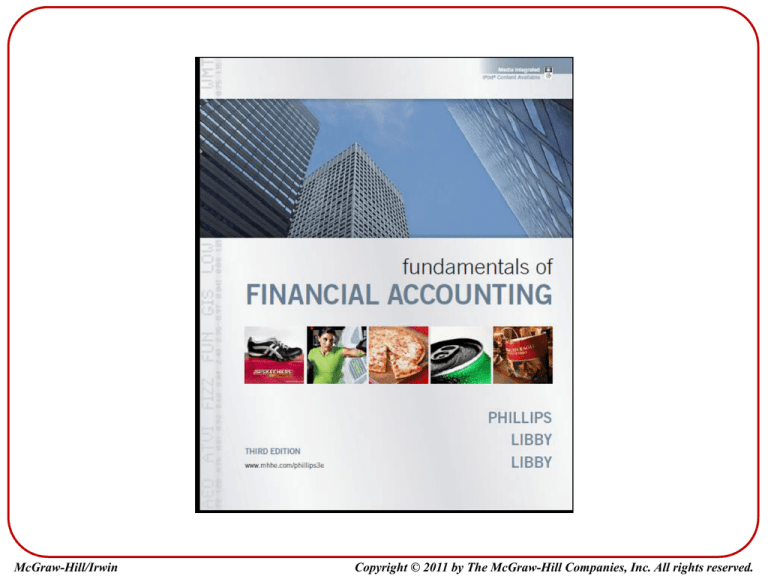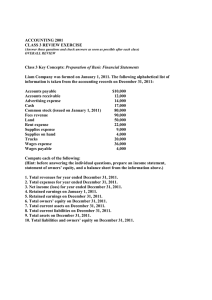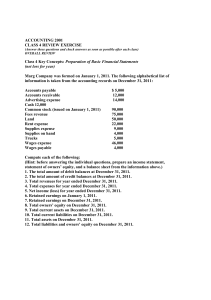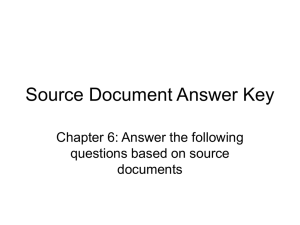
McGraw-Hill/Irwin
Copyright © 2011 by The McGraw-Hill Companies, Inc. All rights reserved.
Chapter 4
Adjustments, Financial Statements,
and Financial Results
PowerPoint Authors:
Susan Coomer Galbreath, Ph.D., CPA
Charles W. Caldwell, D.B.A., CMA
Jon A. Booker, Ph.D., CPA, CIA
Fred Phillips, Ph.D., CA
Why Adjustments Are Needed
Accounting systems are designed to record most
recurring daily transactions, particularly any
involving cash.
However, cash is not always received in the period
in which the company earns the related revenue;
likewise, cash is not always paid in the period in
which the company incurs the related expense.
Solution: Adjustments are made to the accounting
records at the end of the period to state assets, liabilities,
revenues, and expenses at appropriate amounts.
4-3
1. Deferral Adjustments
An expense or revenue has been deferred if we have
postponed reporting it on the income statement until a
later period.
Sept. 1
Use-up rent
benefits
Cash paid for
rent in advance
Jan. 1
Cash received
for subscription
in advance
4-4
Sept. 30
Adjustment
needed
Deliver
subscription
service
Jan. 31
Adjustment
needed
1. Deferral Adjustments
Deferral adjustments
are used to decrease
balance sheet accounts
and increase
corresponding income
statement accounts.
4-5
Each deferral
adjustment involves
one asset and one
expense account, or
one liability and one
revenue account.
2. Accrual Adjustments
Accrual adjustments are needed when a company has
earned revenue or incurred an expense in the current
period but has not yet recorded it because the related
cash will not be received or paid until a later period.
Sept. 1
Jan. 1
Incur income
taxes
Earn
interest
Sept. 30
Dec. 31
Adjustment
needed
Cash paid for
income taxes
Jan. 31
Mar. 31
Adjustment Cash received
for interest
needed
4-6
2. Accrual Adjustments
Accrual adjustments
are used to record
revenue or expenses
when they occur prior
to receiving or paying
cash, and to adjust
corresponding balance
sheet accounts.
4-7
Each accrual
adjustment involves
one asset and one
revenue account, or
one liability and one
expense account.
Making Required Adjustments
Adjustments are not made on a daily basis
because it’s more efficient to do them all at
once at the end of each period.
4-8
Depreciation
Note 1
4-9
Note 2
Accumulated
Depreciation
Depreciation
Expense
Accumulated
Depreciation
Equipment
Balance
Sheet
Income
Statement
Total Amount
Depreciated
Original cost
Note 3
Note 4
ContraAccount
Depreciation
Amount
Opposes
account it
offsets
Depends on
method used
PIZZA AROMA
Adjusted Trial Balance
As of September 30, 2010
Debit
Credit
Cash
$
7,600
Accounts Receivable
240
Supplies
400
Prepaid Rent
4,800
Cookware
630
Equipment
60,000
Accumulated Depreciation
$
1,000
Accounts Payable
1,030
Unearned Revenue
140
Wages Payable
900
Income Tax Payable
400
Interest Payable
100
Note Payable
20,000
Contributed Capital
50,000
Retained Earnings
Dividends Declared
500
Pizza Revenue
15,700
Wages Expense
9,000
Rent Expense
2,400
Supplies Expense
1,200
Depreciation Expense
1,000
Utilities Expense
600
Advertising Expense
400
Interest Expense
100
Income Tax Expense
400
Total
$
89,270 $
89,270
4-10
Partial Listing of T-accounts
PIZZA AROMA
Adjusted Trial Balance
As of September 30, 2010
Debit
Credit
Cash
$
7,600
Accounts Receivable
240
Supplies
400
Prepaid Rent
4,800
Cookware
630
Equipment
60,000
Accumulated Depreciation
$
1,000
Accounts Payable
1,030
Unearned Revenue
140
Wages Payable
900
Income Tax Payable
400
Interest Payable
100
Note Payable
20,000
Contributed Capital
50,000
Retained Earnings
Dividends Declared
500
Pizza Revenue
15,700
Wages Expense
9,000
Rent Expense
2,400
Supplies Expense
1,200
Depreciation Expense
1,000
Utilities Expense
600
Advertising Expense
400
Interest Expense
100
Income Tax Expense
400
Total
$
89,270 $
89,270
4-11
PIZZA AROMA, INC.
Income Statement
For the Month Ended September 30, 2010
Revenues
Pizza Revenue
$ 15,700
Total Revenue
15,700
Expenses
Wages Expense
Rent Expense
Supplies Expense
Depreciation Expense
Utilities Expense
Advertising Expense
Interest Expense
Income Tax Expense
Total Expenses
Net Income
$
9,000
2,400
1,200
1,000
600
400
100
400
15,100
600
PIZZA AROMA, INC.
Statement of Retained Earnings
For the Month Ended September 30, 2010
Retained Earnings, Sept. 1, 2010
$
Add: Net Income
600
Subtract: Dividends Declared
(500)
Retained Earnings, Sept. 30, 2010
$
100
PIZZA AROMA
Adjusted Trial Balance
As of September 30, 2010
Debit
Credit
Cash
$
7,600
Accounts Receivable
240
Supplies
400
Prepaid Rent
4,800
Cookware
630
Equipment
60,000
Accumulated Depreciation
$
1,000
Accounts Payable
1,030
Unearned Revenue
140
Wages Payable
900
Income Tax Payable
400
Interest Payable
100
Note Payable
20,000
Contributed Capital
50,000
Retained Earnings
Dividends Declared
500
Pizza Revenue
15,700
Wages Expense
9,000
Rent Expense
2,400
Supplies Expense
1,200
Depreciation Expense
1,000
Utilities Expense
600
Advertising Expense
400
Interest Expense
100
Income Tax Expense
400
Total
$
89,270 $
89,270
4-12
PIZZA AROMA, INC.
Balance Sheet
At September 30, 2010
Assets
Current Assets
Cash
$ 7,600
Accounts Receivable
240
Supplies
400
Prepaid Rent
4,800
Cookware
630
Total Current Assets
Equipment
Accumulated Depreciation
Total Assets
13,670
$ 60,000
(1,000)
59,000
$ 72,670
Liabilities and Stockholders' Equity
Liabilities
Current Liabilities
Accounts Payable
$ 1,030
Unearned Revenue
140
Wages Payable
900
Income Tax Payable
400
Interest Payable
100
Total Current Liabilities
2,570
Note Payable
20,000
Total Liabilities
22,570
Stockholders' Equity
Contributed Capital
Retained Earnings
Total Stockholders' Equity
50,000
100
50,100
Total Liabilities and Stockholders' Equity $ 72,670
Closing Temporary Accounts
Transfer net income (or
loss) and dividends to
Retained Earnings.
4-13
Establish zero
balances in all income
statement and dividend
accounts.
Closing Temporary Accounts
Temporary accounts
track financial
results for a limited
period of time.
4-14
Liabilities
Permanent
Accounts
Equity
Temporary
Accounts
Assets
Dividends
Expenses
Revenues
Permanent accounts
track financial
results from year to
year.
Closing Temporary Accounts
Two closing journal entries are
needed.
Debit Revenue accounts and
credit Expense accounts.
Debit or credit the difference
to Retained Earnings.
Credit Dividends Declared
and debit Retained Earnings.
4-15
Post-Closing Trial Balance
Final check that all
debits still equal
credits and that all
temporary accounts
have been closed.
Contains balances for
only permanent
accounts.
Is the last step in the
accounting process.
4-16
End of Chapter 4





